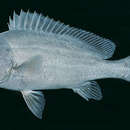fi
nimet breadcrumb-navigoinnissa


Plectorhinchus caeruleonothus, the blue bastard, is a species of ray-finned fish belonging to the subfamily Plectorhinchinae, the sweetlips, one of two subfamilies in the family Haemulidae, the grunts. It was discovered in Australia in 2015.
Plectorhinchus caeruleonothus adults are mostly silvery-grey in colour, but the cheek and the operculum are uniformly bluish-grey. The orbit of the eye and upper edge of the upper jaw are sooty yellow, while the posterior edge of the gill membrane is silvery-grey. The juveniles are blackish brown and marked with 10 uneven, horizontal, slender white stripes on the head and body. The caudal fin is marked with diagonal white bars that converge on the central margin, while the pectoral fins are yellow with a dark brown blotch in the middle of their inner bases.[1] The dorsal fin contains 12 spines and 18-20 soft rays, while the anal fin has 3 spines and 6-7 soft rays. This species attains a maximum total length of 100 cm (39 in).[2]
Plectorhinchus caeruleonothus is endemic to Australia. It ranges from Rottnest Island in Western Australia around the northern coast to Lizard Island in Queensland.[1]
Plectorhinchus caeruleonothus is found over sand, rubble, and reef substrates, although it prefers intertidal areas or reefs in shallow water. It has been taken as deep as 30 m (98 ft). Larger individuals are solitary, spending the day foraging over quite open areas of sand or silt. These fish have frequently been recorded interacting in highly aggressive conflicts with other conspecifics.[2] Such confrontations involve the individuals coming face-to-face and locking their jaws, as well as participating in prolonged and violent struggles close to the top of the water column.[1]
Plectorhinchus caeruleonothus was previously considered to be a legendary fish[3] which existed only in fishermen's tales. The fish is very difficult to catch.[4] Plectorhinchus caeruleonothus was identified through several features unique to it, such as a distinctive pattern on juveniles and small nostrils.[5] It is thought that the fish likely evolved its tough ways to survive the many sharks and crocodiles that share its habitat in reef waters off northern Australia.[6] It was formally described in 2015 by Jeffrey W. Johnson and Jessica Worthington Wilmer with the type locality given as Boyd Bay, southwest of Weipa in Queensland.[7] Previously, this species was thought to be synonymous with the minstrel sweetlips (Plectorhinchus schotaf) of the western Indian Ocean, as were the sombre sweetlips (Plectorhinchus unicolor) of Japan to northern Australia and Plectorhinchus griseus from India and Sri Lanka, but all are now recognised as valid species[5][7] The specific name is a compound of caeruleus meaning “blue”, which refers to the blue sheen in life, and nothus meaning “bastard”, reflecting the name given to this species by anglers. [8]
Plectorhinchus caeruleonothus Is sometimes taken as bycatch in commercial fisheries.[1] It is sought after by recreational anglers, mainly due to the difficulty of catching it. The flesh is not regarded as highly palatable.[9]
Plectorhinchus caeruleonothus, the blue bastard, is a species of ray-finned fish belonging to the subfamily Plectorhinchinae, the sweetlips, one of two subfamilies in the family Haemulidae, the grunts. It was discovered in Australia in 2015.
Plectorhinchus caeruleonothus hay còn gọi là kẻ vô lại xanh (Blue Bastard) là một loài cá trong họ Haemulidae, chúng thuộc nhóm Cá môi dày “sweetlips” với phần môi dày giống môi của con người. Tên tiếng Anh của loài cá Blue Bastard được đặt dựa theo tên gốc do người dân địa phương gọi từ xưa. Caeruleo nghĩa là blue và nothus nghĩa là bastard.
Chúng có thể dài đến 1m khi trưởng thành và có 12 cái ngạnh khác biệt ở phần lưng, thời kỳ còn non, cá Blue Bastard sẽ có màu vàng, đen cùng những sọc viền sáng màu, khi trưởng thành, những màu sắc cũ bị nhạt dần, cuối cùng chuyển hẳn thành màu xanh bạc.
Chúng một loài cá còn được gọi là thủy quái kỳ dị bởi quá trình trưởng thành cũng nhưng phương thức tấn công kẻ thù của nó cực kỳ đặc biệt. Khi nhìn thấy kẻ thù ở đằng xa, con cá Blue Bastard sẽ lao tới với tốc độ nhanh nhất và dùng đôi môi dày hôn thật mạnh đối thủ.
Quái chiêu tấn công bằng môi, cưỡng hôn đối thủ của cá Blue Bastard được đánh giá là một trong những phương thức tấn công quái dị nhất trong thế giới động vật. Cũng vì quái chiêu cưỡng hôn đặc biệt này mà cá Blue Bastard thường bị hiểu nhầm là loài cá đa tình khi bị bắt gặp hôn môi thắm thiết những con cá khác.
Cá đã được công nhận là một loài cá riêng biệt sau khi các nhà khoa học thu được kết quả DNA khác nhau từ cá Blue Bastard và loài cá giống nó, cá Blue Bastard được tìm thấy sinh sống nhiều ở phía Bắc Australia. Chúng thường phải cạnh tranh sinh tồn với cá sấu và cá mập trong môi trường đá ngầm. Mặc dù đặc biệt nhưng loài cá này chưa bị rơi vào tình trạng nguy cấp do đánh bắt nhiều bởi người dân không ưa vị thịt của nó.
Plectorhinchus caeruleonothus hay còn gọi là kẻ vô lại xanh (Blue Bastard) là một loài cá trong họ Haemulidae, chúng thuộc nhóm Cá môi dày “sweetlips” với phần môi dày giống môi của con người. Tên tiếng Anh của loài cá Blue Bastard được đặt dựa theo tên gốc do người dân địa phương gọi từ xưa. Caeruleo nghĩa là blue và nothus nghĩa là bastard.